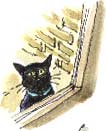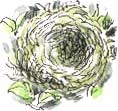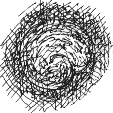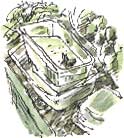 A SLEEK BLACK CAT is enjoying the early morning sun-trap of our patio when
I go down to put the kettle on. It looks at me through the pane in back door
with an expression of incredulity and puzzlement.
A SLEEK BLACK CAT is enjoying the early morning sun-trap of our patio when
I go down to put the kettle on. It looks at me through the pane in back door
with an expression of incredulity and puzzlement.The Sun Trap Cat |
Richard Bell's Wild West Yorkshire nature diary, Sunday, 26th August, 2007 |
 A SLEEK BLACK CAT is enjoying the early morning sun-trap of our patio when
I go down to put the kettle on. It looks at me through the pane in back door
with an expression of incredulity and puzzlement.
A SLEEK BLACK CAT is enjoying the early morning sun-trap of our patio when
I go down to put the kettle on. It looks at me through the pane in back door
with an expression of incredulity and puzzlement.
 A Nest in the Elder
A Nest in the ElderTrimming my way along, halfway down the hedge by the vegetable beds, where an elder sticks up amongst the hawthorns, I find this old nest the size of a small soup dish. It has no mud lining, so it’s unlikely to be either a blackbird or song thrush; it’s probably a hedge sparrow, usually called a dunnock these days, as it’s not closely related to the house sparrow. Some birders would call it a hedge accentor, to bring it in line with the other four European species in the genus. The genus is, charmingly, Prunella and the dunnock is Prunella modularis.
NEST. Of moss, wool, grass and hair ; in a bush or hedge, or in a brushwood or faggot pile.
S. Vere Benson, The Observer’s Book of Birds, 30th Edition, 1958
![]() My
favourite recent bird book, the Collins
Bird Guide gives far more information on the field characters of the dunnock
than the Observer’s Book but only a brief mention of the whereabouts
of the nest - ‘in thick bush or
low
down in a conifer’ (whatever happened to 'faggot piles'?) - and no clues
as
to
its
construction.
My
favourite recent bird book, the Collins
Bird Guide gives far more information on the field characters of the dunnock
than the Observer’s Book but only a brief mention of the whereabouts
of the nest - ‘in thick bush or
low
down in a conifer’ (whatever happened to 'faggot piles'?) - and no clues
as
to
its
construction.
 About 20 years ago,
Barbara’s dad and I planted hollies at the bottom
of the garden as the old hawthorn hedge alongside the meadow was, in the
opinion of the British Trust for Conservation Volunteers, too overgrown to
rejuvenate
by laying. We dug a trench and added plenty of garden compost and the hollies
soon became established. Now I’m working at shoulder height to trim
the top of the hedge (the ground is higher on the other side of the hedge).
About 20 years ago,
Barbara’s dad and I planted hollies at the bottom
of the garden as the old hawthorn hedge alongside the meadow was, in the
opinion of the British Trust for Conservation Volunteers, too overgrown to
rejuvenate
by laying. We dug a trench and added plenty of garden compost and the hollies
soon became established. Now I’m working at shoulder height to trim
the top of the hedge (the ground is higher on the other side of the hedge).
Up amongst the branches, resting on a holly leaf, I noticed a stripy snail, a brown-lipped, tucked snugly into its shell. I wonder what it was doing up there.
 Up the Spout
Up the Spout As
I watered in the greenhouse this evening, I found the flow from the watering
can cut off to no more than a trickle as I tilted it. This has
happened before; while
the
can was empty a garden snail had decided that the entrance
to the spout was the ideal place to hunker down. Another watering can in
the greenhouse had
two snails living in it.
As
I watered in the greenhouse this evening, I found the flow from the watering
can cut off to no more than a trickle as I tilted it. This has
happened before; while
the
can was empty a garden snail had decided that the entrance
to the spout was the ideal place to hunker down. Another watering can in
the greenhouse had
two snails living in it.
I threw them over the hedge into the meadow, but I don’t think this is how the brown-lipped snail came to be lodged high in the hedge. There is probably some good reason for it to have made its way up there amongst the waxy, prickly leaves of the holly, which can’t make good eating.
 When
the rabbit started snipping away our newly planted cabbage
and broccoli in the early summer, I hurriedly covered them with makeshift
cloches of propagator
tops and an old cracked plastic aquarium. The plants soon became stunted
as they pushed up inside the confined space so I put the cloches
down
by the hedge and fenced off the brassicas with netting.
When
the rabbit started snipping away our newly planted cabbage
and broccoli in the early summer, I hurriedly covered them with makeshift
cloches of propagator
tops and an old cracked plastic aquarium. The plants soon became stunted
as they pushed up inside the confined space so I put the cloches
down
by the hedge and fenced off the brassicas with netting.
 I
noticed that the aquarium had partly filled with water but thought, that’s
OK, it’s another micro-habitat for pond life, but I regret that now
because today I spotted that a young nestling, probably a blue tit,
had plummeted in
there and drowned.
I
noticed that the aquarium had partly filled with water but thought, that’s
OK, it’s another micro-habitat for pond life, but I regret that now
because today I spotted that a young nestling, probably a blue tit,
had plummeted in
there and drowned.
We’re still trying to find a place for everything in the garden but I’ll make a point of leaving any such rain-trap upside down.
There are so many mosquitoes around at the moment, many of them feasting on Barbara and I, so it’s not a good idea to leave little pools of still water sitting around the garden. At least in the garden pond there are plenty of frogs, newts and water beetles to keep the mosquito larvae under control.